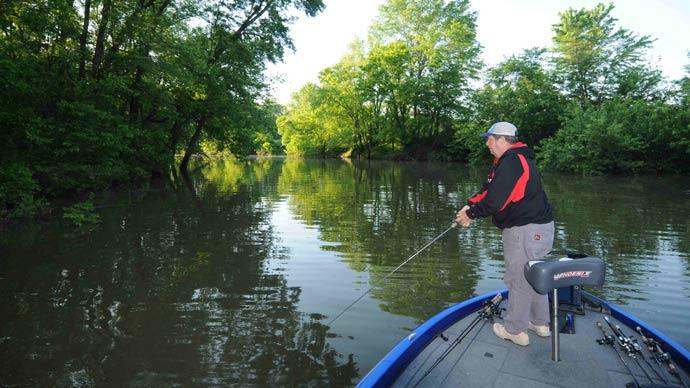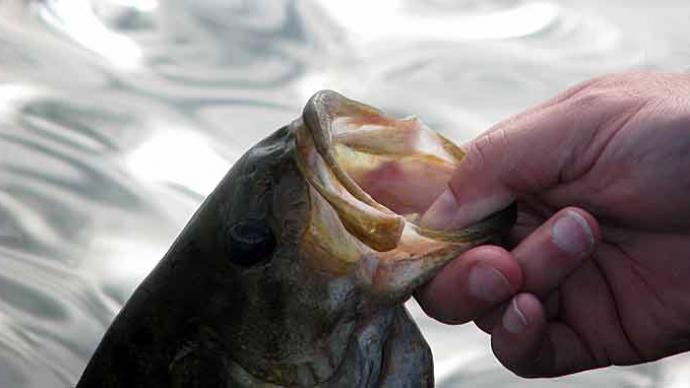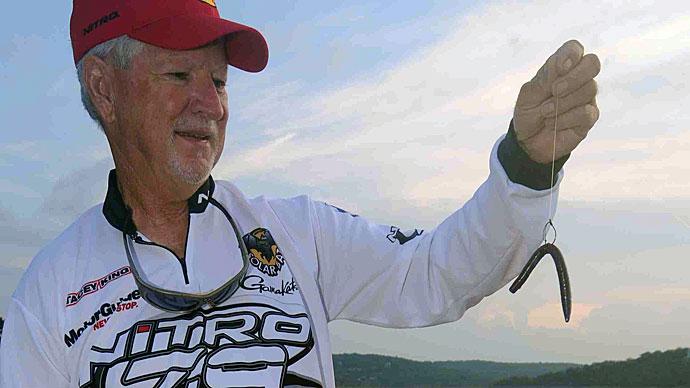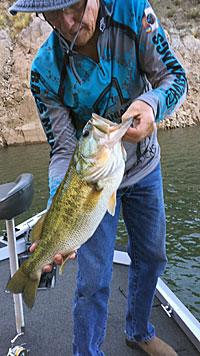
One Arizona pro says this lure “teaches people to be lazy fishermen–it’s too easy!” Other Arizona anglers call it the “limit finder.” It doesn’t require baitcasting equipment, and you don’t have to set the hook. Because of this, it’s the ideal bait for a bass fishing newcomer or a youngster. Yet, several companies make dozens of colors and styles, red, black, purple, and green are Arizona’s favorites.
This lure, the double-hooked, pre-rigged worm, is probably responsible for more big bass than any other lure in the state. In Arizona, a double-hook worm usually means a Westy Worm. The originals were made with super floater worms but grew to various sizes and colors. These are different from Do-Nothing worms because they are rigged on a jighead.
Many anglers consider a Westy Worm primarily a deep-water structure lure. However, this lure is every bit as effective in shallow water. Docks and piers are ideal locations, especially after the sun has been out for a couple of hours. Steep rocky banks are also good places to try the Westy, especially where the rocks and clefts create shady areas and the bank runs straight up and down. These rocky banks are covered with hiding holes that crawdads love to use, and bass love to eat crawdads. The Westy moves like a craw, and sometimes a bass slams one then comes back as if he had smacked a craw to disable it before coming in to swallow it.
Many years ago, I learned to run these steep banks and cliffs, fishing the Westy from zero to 40 feet deep. Just toss it out, let it drop, and wait until the line goes slack. This lets you know the lure has hit bottom. Reel up the slack, gently pull the lure out and let it drop to the bottom again. At some point, you’ll feel pressure when you pull. That’s the bite. When this happens, reel quickly. There’s no need to slam the hook home – the sharp, fine hooks set themselves. Another good technique on steep banks is to cast or drop the worm, count it down, and shake it a few times before pulling it to another location.
A lot of times, you will discover what the fish want by accident. For instance, you may get snagged on a small rock, and a fish grabs it when you pull the lure free. Or you may get a loop in your line, and while sitting there playing with your reel, a fish may take your worm. Sometimes the bass want the lure worked fast, and you may not realize it until a fish grabs it as you reel in quickly to throw it to another spot. It’s essential to pay attention to where and how the lure was taken. If you repeat the process, you increase the odds of catching more fish.
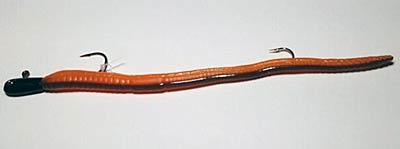
A good Westy worm rod is a 6 ½- or 7-foot spinning rod with a bit of give. A too stiff rod will tend to make you lose fish, either by tearing the hook free or straightening out the hook. Light line is best for Westys, and most anglers use 8- to 10-pound-test line no matter how shallow or deep they are fishing. A Westy worm is an open-water lure, so you shouldn’t have to worry about dragging any big fish through the brush.
When structure fishing is the day's bite, the Westy shines. Dan Westfall (original owner of the Westy Worm – hence the name) has definite ideas on how to go about fishing structure. First, he says to look for structure on a map. Mark likely-looking spots on your map–it is much faster to do it that way than to drive all over the place watching a graph.
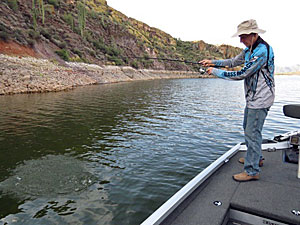
The shallower the structure, the better it will be, says Westfall, because the deeper you go, the harder it is to catch the fish. A depth of 15 to 20 feet is his target. Once you investigate the structure with a depthfinder, look to see if the fish are close to it. Dan says not to bother fishing for them if the fish are away from the structure or hanging way above it. Fish close to the structure are the active ones, and you can catch them. The others are inactive and are probably not catchable.
According to Westfall, the deeper you are fishing, the more critical boat control becomes. He says anchoring is great when the bite is slow and challenging, and you must keep your lure on the bottom. However, he prefers shallower, more active fish. “Always fish as fast as you can get away with,” he said. He says the key to working a Westy is to use the reel to control the bait. Keep the rod down and your hand in front of the reel. Use the reel to move the bait. Westfall says to throw the worm out and let it go to the bottom while pointing the rod in that direction. When the lure hits bottom, crank three or four times as fast as you can. “Don’t have preconceived notions,” he said. “Start fast for two or three casts, then slow down and slide it around on the bottom.”
There is another technique for fishing these worms that can bring spectacular results. Mark Kile and Ben Matsubu are two anglers who have been given credit for this technique. It is almost like spooning a worm. You position the boat close to the structure you want to fish, cast out the Westy Worm and let it drop. You can use either reel it in an instant it hits bottom, hop it three to four feet up, let it fall back, and reel it in and start over. If you are on good structure and there are fish that don’t seem to want to bite, this technique could pay off.
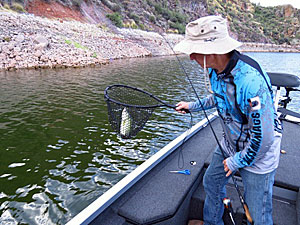
John Murray told us that he once caught all his fish in a tournament by ripping a Westy like a jerkbait under the tires in the marina. I once caught several fish in a row just trolling a Westy Worm behind the boat. I had given up on trying to fish it “properly” because the boat was going too fast to allow the light lure to get to the bottom, so I just let it drag behind the boat, just off the bottom. The fish just hammered it. I call this the non-boater Westy technique.
Catching fish on the Westy isn’t a problem. They seem to like it no matter how you present it to them. Once you have a fish on, you must do a few things right to get him in the boat. If you have started with a long medium-action rod, you’re on your way to success. You want to avoid giving the fish any slack and try not to switch directions on him. Keep him moving the same way and let him run around for a bit. Try not to let him jump because that might give him enough slack to shake the hook. Keep the drag set reasonably light, and use your hand on the spool to reel-set. Once the hook is in, let go and let the drag get the fish ready to boat. A net will come in handy, too. Murray says he’s never lost a fish on a Westy, but he’s the only person I have ever heard make that claim.
Many fishermen use scent on Westys, and Murray used to keep Berkley Power Worms in the bag with his Westys to give them some scent. Some anglers remove the back hook to make them less likely to snag, but if fish are slapping at a lure, that back hook can be the only thing that catches them. The light-head worms are the most popular–either the 4-inch or the 6-inch. Red is the most popular color during the day, with purple running a close second.
If you had to go out fishing with only one kind of lure, you could do worse than to choose the Westy worm. Grab a handful and try them out this winter. It’s about as close to a guarantee as you can get when you’re going fishing.


